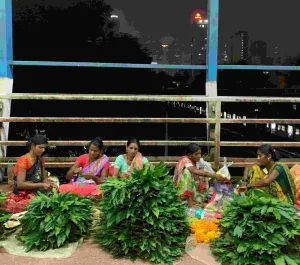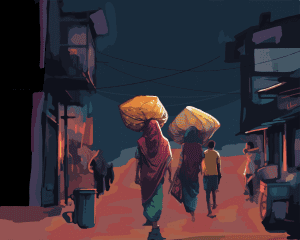Inside The Lives, Labour And Trials Of Chennai’s Women Flowersellers
Hawking flowers at almost every street corner, women are the most visible faces of the flower business in Tamil Nadu. But they occupy the last and least profitable rung of the trade even as they battle precarity, heat, exhaustion and eviction
- Archita Raghu

Equipped with pearly white mullai (jasmines), a reel of white thread, and a pair of trusty scissors, Ammu’s fingers deftly weave a muzham, an elbow-length string of flowers. This task takes her just 10 minutes (experience, she says with a laugh). But the fragrance and pain of the labour lingers on her cracked fingertips all day.
“Our work is difficult, but flowers make a woman much more beautiful. In this world, you won’t find anyone who hates flowers,” says the 45-year-old street vendor, placing garlands and flowers on a crate that is her makeshift table at the Abhiramipuram main road in southern Chennai.
For Ammu, flowers are “thozhil, ulaippu, coolie (work, hard and informal labour)”, a day’s meal for her family and the means to repay the interest on a Rs 40,000 loan.
Flowers are integral to everyday life in Tamil Nadu, artfully tucked into braids, strewn along the path of funeral processions, woven into wedding rituals, and draped around the necks of politicians, a marker of fandom and adulation. And women are the most visible backbone of this informal flower economy though they mostly occupy its lowest rung – as hawkers squatting at street corners, temple gates and market pavements and as farm labour on jasmine fields. Men rule the more profitable wholesale and retail markets in the business.
R Geetha, advisor to the Unorganised Workers Federation (UWF), says that the work of these women is marginalised exactly like that of fisherwomen who are left out of fishing ban compensations. Hawkers like Ammu earn anywhere between Rs 500 to Rs 1000 a day depending on season and sales. A kilo of jasmine that costs Rs 210 on an average day in the wholesale market could command Rs 300-500 in the wedding season. Some days, there is no profit at all, only losses, and daily debts to be repaid, the women say.
Then there are eviction alarms from the city corporation. For 39-year-old Sumathi*, who works at the entrance of the Koyambedu wholesale flower market, eviction raids by the Chennai Metropolitan Development Authority (CMDA) are a regular occurrence. “They take away our crates and flowers, we have to go after them begging for our things. They say we have to make space for shoppers,” she says. During Deepavali or Ayudha pooja, these raids increase, she adds.
Hawkers are now expected to have vending licences issued by the city corporation, and they last for three years. Some of the women flower sellers near the market areas of Parry’s and Koyambedu say they have these licenses while others say that the documents offer no protection from raids.
We at Behanbox have been intently following the lives and livelihoods of women vendors in our stories. We reported on Mumbai’s flower hawkers, whose workdays begin in the jungles on the far outskirts of the city. We investigated, in a three-part series, the lives of women vendors who run a pre-dawn second hand clothes market in west Delhi, caught in a spire of work that leaves no room for sleep or rest. And we wrote about the constant threat of violence and evictions hanging over the heads of Mumbai’s women hawkers.
On The 3 AM Bus To Parry’s
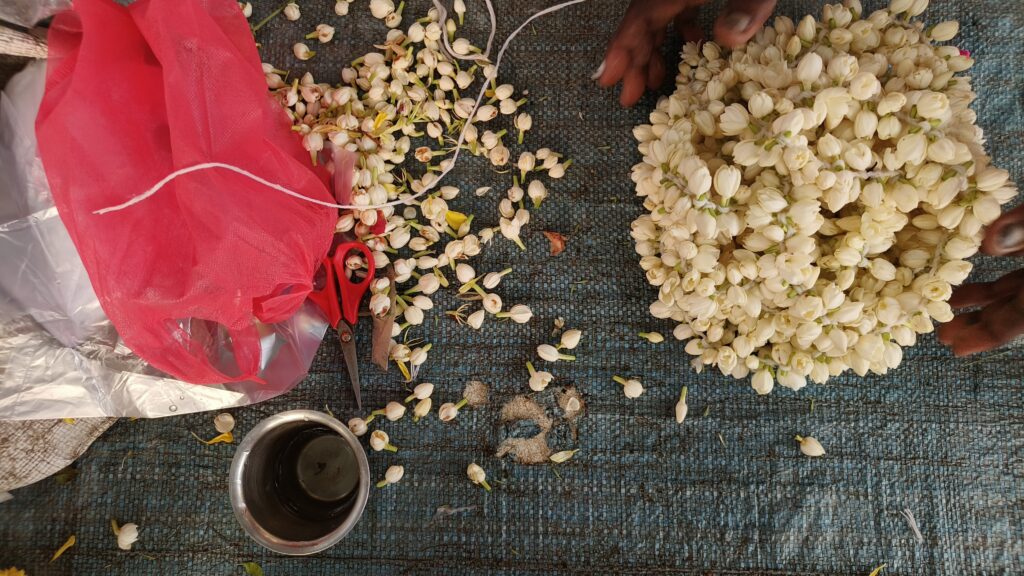
Ammu’s skills go beyond threading flowers. She is keenly attuned to seasonal festivals, rituals, rites and local happenings that could boost the demand for her flowers – a death, the coming of age of a girl or the start of a pregnant woman’s third trimester. “Rain or shine, Covid or fever, we work every day. Indha poo thozhil la kaanjipeirkom (this flower business drains us out). We earn enough to eat and pay rent; I pray to god to rid us of our troubles,” she says, glancing at the temple behind her.
As the rest of Chennai slumbers, around 3am, Ammu boards the pink 21G bus from her home in Mylapore to the Parry’s wholesale flower bazaar, a journey that takes anywhere between 30 to 45 minutes. There are also days when she squeezes into a shared auto heading to Parry’s. She will return yet again to this wholesale market from her Abhiramapuram stall at 1 pm to buy just jasmines, a popular flower which arrives in the city from the fields only by late morning or noon.
Weaving these flower muzhams and dealing with customers takes up the rest of her day. “Rest is not an option in our lives,” she says as she laughs wryly. While her routine is set, her income is not. She buys flowers for Rs 1000-2000, and on rare good days, there’s a profit of Rs 250- 500.
Ammu knows her customers by name, profession, and their flower choices – mallipoo (jasmine) with slide pins for women or for men to gift their wives, chrysanthemum for local pujas, a mix of flowers for parents praying for their children’s exam results, and fresh roses for young men attempting to woo lovers. It’s crucial for business, she advises, to know your customer and know their demands. A customer says that Ammu is a “superstar” who holds the neighbourhood together, and jokes that she is the inspiration behind Meena, a character who runs a flower business in the TV soap Siragadikka Aasai.
“Just as the kanthal (Gloriosa superba or the glory lily) is the Tamil Nadu state flower, every ancient dynasty had a flower, which they wore for significant events. The Cholas had the aathi, the Cheras had ponthai, the Pallava flower was thondai, and the Pandyas had the neem flower. So rich was the flora then that the Tamil Sangam work ‘Kurinji Pattu’ lists the names of 99 flowers, which gave the ancient Tamils a huge variety of flowers with which to adorn themselves. Sangam literature also talks about how war-loving early Tamils (between 3 BC and 3 AD) had a set of guidelines they followed during war,” writes historian Meenakshi Devaraj. Jasmine is a recurring motif in Tamil literature, especially Sangam poetry, a symbol of longing and desire.

This floral metaphor also sneaks into popular Tamil music – film songs and ringtones. There is singer Vani Jairam’s 1970s hit Malligai En Mannan for example, and more recently Madhushree’s viral hit Mallipoo.
But the suppliers, vendors and informal workers are all missing from this literature.
Sujata Mody, president of the Penn Thozhilalar Sangam, says the women flower hawkers live in a state of precarity. “I find these vendors independent financially but the economy is hidden wage labour because they rely on loans. There’s no idea of dignity of labour and the government doesn’t see the need to provide them security or toilets,” she says.
While garment workers, and domestic workers have unions, there are none for the women street vendors. “In the 80s and 90s, they tried to unionise but it was difficult; there was competition, and the groups broke away quickly,” she says.
Learning The Craft
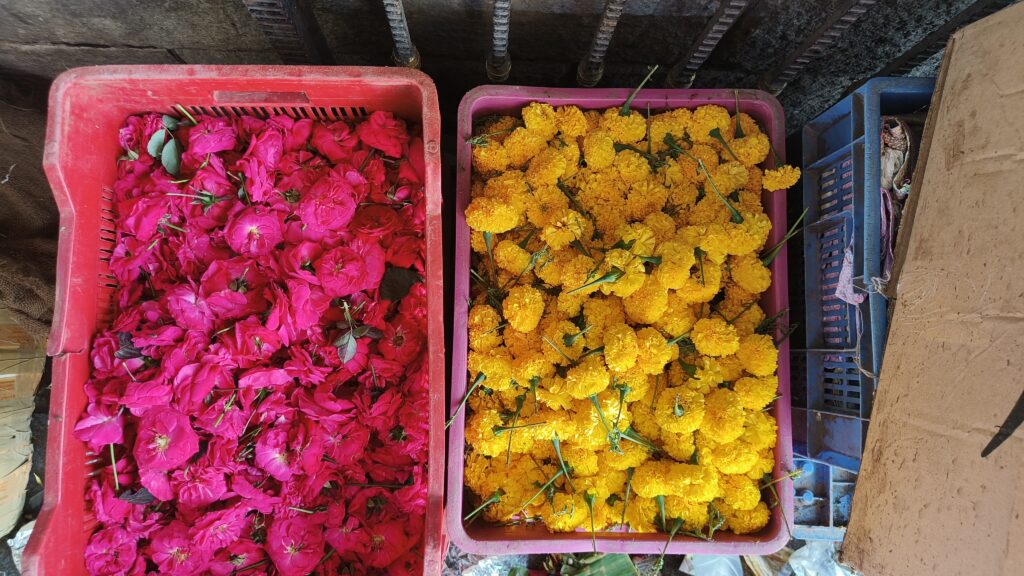
Kuppi and her daughter Mohanapriya, 15, are both in the flower business but they rarely wear flowers in their hair. “We work at home, go out in the sun, so women in our households don’t wear flowers for long,” says Kuppi, who hawks flowers in RA Puram.
In the streets behind the Mylapore Mass Rapid Transit Station, it is common around 2pm to see women stringing jasmine flowers. We found some instructing their daughters – some as young as five – in the skill of flower weaving, using cut-up bits from a stick broom and a string.
“The first three fingers are the most important. Hold the jasmine stems poo oda poo (one on top of the other), loop, and then knot. Soon, your fingers will know what to do,” says Mohanapriya. By the age of nine, she had learnt that jasmine stems needed special care, that the art of balance was crucial, and that there were four ways to loop the flowers. But the thalla-kezhai method (head-down) was the teen’s preferred one.
“If you’re afraid of flowers breaking and dying, this field isn’t for you,” she says. From water shortages to root decay and fluctuating prices, the flower business is highly precarious. But Kuppi hopes this business stops with her generation, and her teenage daughter scores top marks to join high-paying professions.
Anxious about her board exam results, Mohanapriya says maths is her “best subject” because dealing with the flower business has taught her to calculate quickly and remember sums. “My school lessons are easier than this,” she says. Usha, a flowerseller in Mylapore, wants to make enough money to build a house for her daughter, and *Shantha wants to pay off her loans so her children are debt free.
Around 15 km from Mylapore, at Parry’s Corner, there are allied flower trades running on the snaking lanes of the flower bazaar. Amid the shouts of mallipoo, mupathu, mupathu, (jasmine, for Rs 30) honks of bikes and rickshaws, Durga put finishing touches to the fourth poo jaada (flower braid) she has crafted today. Discipline is at the centre of her artistry, and these sounds are not distracting her.
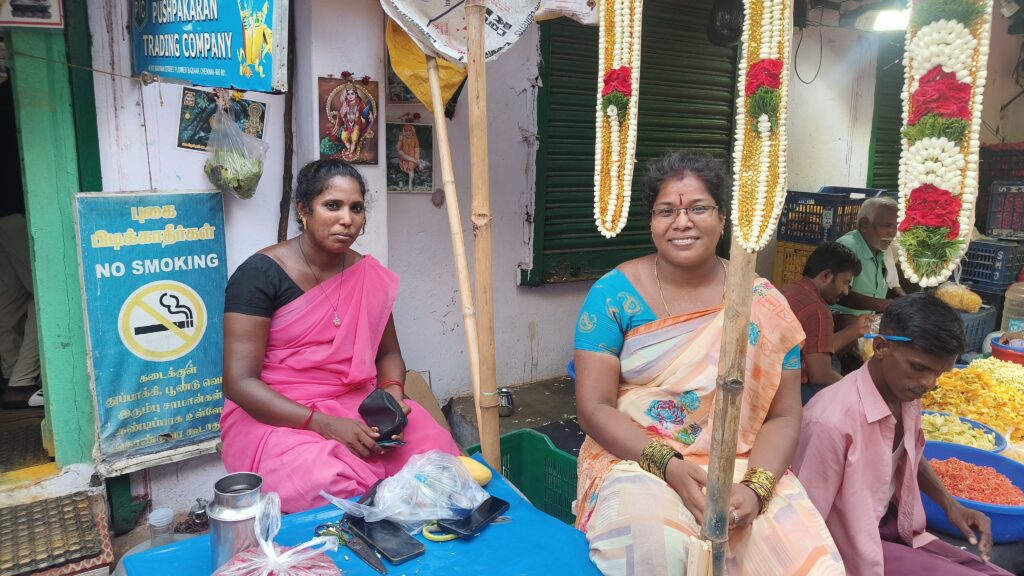
For the past 30 years, Durga and Chitra have been designing flower braids for brides and pregnant women; they also do decorations for wedding nights and political campaigns. “We keep up with trends, and keep up with what women like,” she says.
Durga’s gallery is like a Pinterest board – dozens of flashy photos of her designs, fruit jaadas peppered with cashews, dolls, cherries, and popular ones called Surya-Jyothika jaada (named after the famous star couple).
“At night, my mind runs thinking of designs. I sleep and dream of designs. I asked pregnant women what they like, what they are craving food-wise, and design based on what they want,” she says. The two sell a single braid for Rs 2000 to 3500, depending on materials used.
No Time For Selfcare, Health
Most women flowersellers we met said that per the diktats of convention, they do not wear flowers in their hair because they are widowed or abandoned. Some said that working with heavy floral fragrance the whole day makes their head hurt.
There are other issues of poor health, caused by exposure to heat and fatigue. Ammu, for instance, says she has never taken a day’s leave since she began work as a 14-year-old. She has now been nursing fatigue and fever for over a month. “I fell sick from the heat and got gastritis from drinking bottled soda. The doctor said it was also because of stress. But my customers are flighty – if I take a day or two off, they’ll go somewhere else,” she says. Chennai and other parts of Tamil Nadu have been experiencing scorching summers and the women sit on streetsides with little access to shade, water or toilets.

Most flower vendors BehanBox interviewed spoke of aches in their joints, fingers, feet, knees and shoulders from their hectic commutes, work and having to stand for long hours at work. Others used words like tension, kashtam (difficulty) and pain to express distress.
“Often, I wonder what would happen if I were never born or just disappeared one day,” says Ammu. Informal workers report high levels of precarity, and according to the National Crime Records Bureau, 21% of total deaths by suicide were of daily wage labourers.
In Koyambedu, lotus vendor Dharani was subjected to slurs, verbal and physical abuse by two men in the market, “Even now, I think of the incident and feel furious,” says the 40-year-old flower seller. She adds that the merchant association in that area lacks women leaders, invisibling the struggles of women.
Eviction Fears
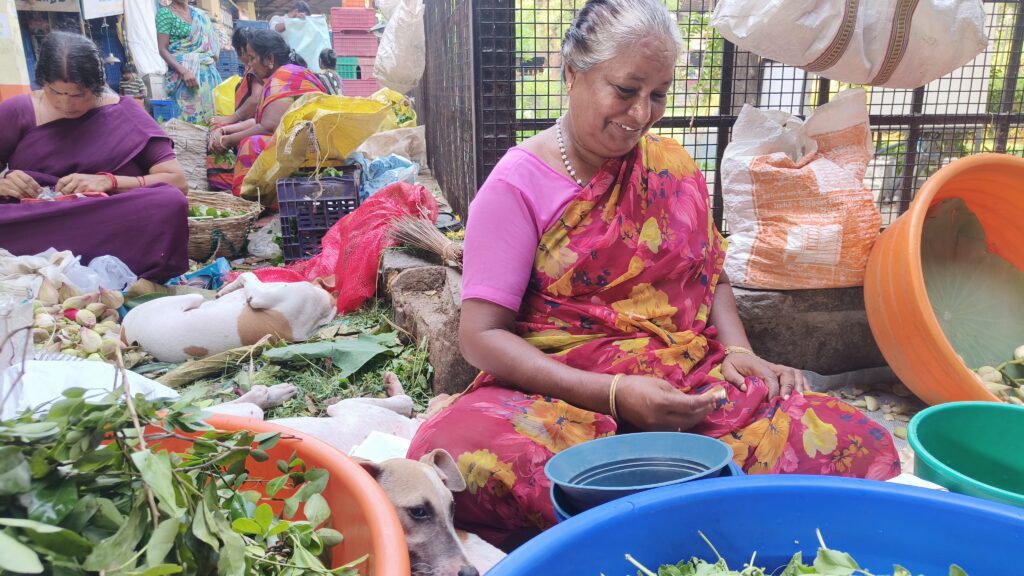
There are around 3,855 wholesale flower shops at Parry’s, a CMDA official tells BehanBox. Sumathi, a flower hawker at Parry’s, alleges that the aggressively competitive men who run these shops ask the CMDA to conduct eviction raids on women hawkers in the area.
“Those who have wholesale shops are those with money, and those with roots in the Parry’s flower market that shifted to Koyembedu over three decades ago,” she says.
There have been eviction drives in the Koyembedu market area to free up pedestrian paths. In Parry’s Corner too, there have been evictions, following a high court order directing the corporation to maintain the NSC Bose Road as a ‘No Hawking Zone’. But vendors are resisting the idea of a hawking zone because they believe it will hit their sales.
According to a CMDA official, who preferred to be anonymous, street vendors without licenses are evicted by the corporation while the traders within the Koyambedu market come under the purview of the Metropolitan Development Authority. “Evictions occur daily within the market; the ones without licenses from the Market Management Committee are considered encroachers. The licenses have to be renewed every three years, and without this, their shops will be locked and sealed,” says the official, adding that the market, one of Asia’s largest wholesale markets, sees at least 2000 tonnes of flowers coming in per day, and requires regulation.
“It is estimated that in several cities street vendors count for about 2 per cent of the population. Women constitute a large segment of these street vendors in almost every city,” reports the National Policy on Urban Street Vendors, 2009. Last year, the Greater Chennai Corporation was set to finalise 776 vending zones and 493 non-vending zones for nearly 35,588 registered street vendors in Chennai. The Street Vendors (Protection of Livelihood and Regulation of Street Vending) Act in 2014 was also meant to protect vendors from eviction. But as we have highlighted, in Mumbai and Delhi, slow and patchy implementation of the act has made arbitrary evictions a part of every vendor’s life.”
Even having a vending license is no protection from eviction, says Sumathi. “Those who come to evict us tell us these are just like ID cards, and don’t give us the right to be here. They call us platform vendors. There’s no connection between the card and our right to have a space here,” says Sumathi.
We believe everyone deserves equal access to accurate news. Support from our readers enables us to keep our journalism open and free for everyone, all over the world.
